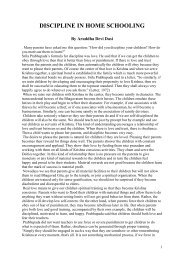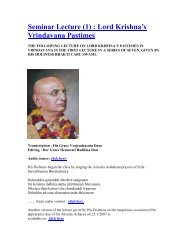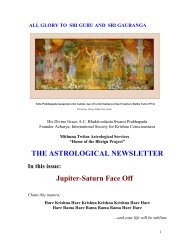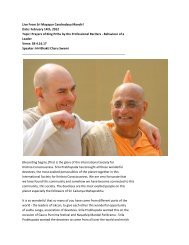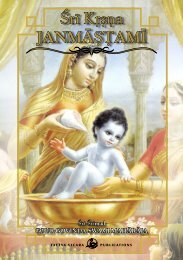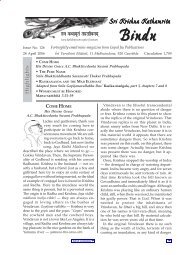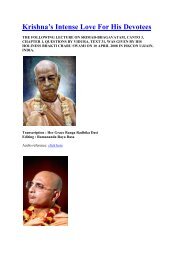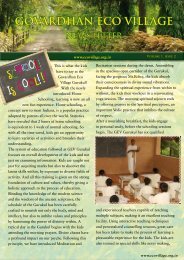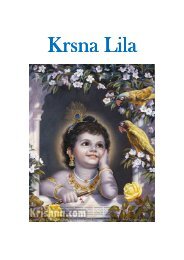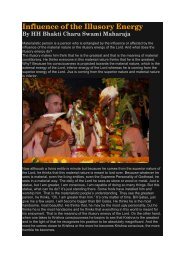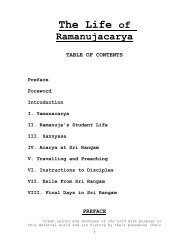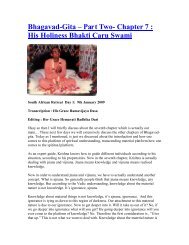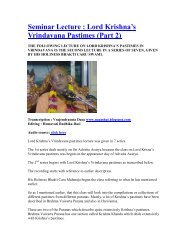Gaudiya siddhanta - ebooks - ISKCON desire tree
Gaudiya siddhanta - ebooks - ISKCON desire tree
Gaudiya siddhanta - ebooks - ISKCON desire tree
Create successful ePaper yourself
Turn your PDF publications into a flip-book with our unique Google optimized e-Paper software.
gaudiya school, he is noble and bold enough to publicly acknowledge it’s contribution to humanity at<br />
large, and accept the <strong>Gaudiya</strong>s as a branch from the Madhva sampradaya.<br />
Our Tattvavadi friends may try to cover up the above statements spoken by the Swamiji explaining that<br />
he is simply being polite and trying to be harmonious and friendly. However, we, at least, find it hard to<br />
believe that someone of the straightforward nature of Sri Pejavara Swamiji would stoop to trying to<br />
'please every Tom, Dick and Harry' by compromising the philosophy and mood of Madhva. Did the<br />
Swamiji ever express such eulogies for Jayendra Sarasvati, Bharati Tirtha, Ganapati Sacchidananda, Sai<br />
Baba or any other such personage? Were they or their followers ever invited to annually participate in<br />
an important function in Udupi? We would deem it highly unlikely…<br />
CONCLUSION: It can therefore be concluded that the gaudiya vaishnava Parampara is a genuine<br />
branch of the Madhva sampradaya, although it is acknowledged that there are certain differences in the<br />
sadhana (process) and sadhya (goal) of the two schools.<br />
We wish to point out here that although we have objected to the antiquity of the Madhva parampara,<br />
which has been presented by previous dvaita acaryas, in fact we find no fault in what they have said.<br />
We merely wish to point out that the arguments presented by the challenging party can logically also be<br />
raised against their own tradition.<br />
As stated previously, it is the firm belief of the <strong>Gaudiya</strong>s that the teachings propounded by Madhvacarya<br />
are an important step in the evolution of theism culminating in the sublime acintya-bheda-bheda-tattva<br />
doctrine of Sri Caitanya Mahaprabhu.<br />
________________________________<br />
(1) sri madhvamatte harih paratarah satyam jagattattvato bhinna jivagana hareranucara nicocchabhavam gatah<br />
muktiranujasukhanubhutiramala bhaktisca tatsadhanam hyaksaditritayam pranamakhilamnayaikavedyo harih //<br />
(2) In his book Life Teachings of Sri Madhwacharya, the Dvaita scholar Sri C.M. Padmanabhacharya writes -"Sri Chaitanya<br />
steered clear of these subtleties. He did not trouble himself to build up a system or think of details for a code of religion.<br />
His life shows that he was an uncompromising Dualist (Dwaiti)." Although we beg to differ on certain points in this quote,<br />
it is interesting to note that such a revered Dvaita pandita as Sri Padmanabhacharya accepted Mahaprabhu as being in<br />
the Madhva line.<br />
(3) The History & Literature of the gaudiya vaishnavas and Their Relation to Other Medieval Vaishnava Schools by Dr.<br />
Sambidananda Das p.99 - "Sri Chaitanya Himself visited the head-quarters of the Madhva sect at Udupi and had<br />
discussion with its head Raghuvarya Tirtha, but He differed from him as to the conception of sadhya and sadhana... Sri<br />
Chaitanya Deva and the writers of His sect accepted Madhva's views from his various writings and the particular line<br />
through which they traced their own origin to the Madhva sect, and that particular line was somewhat different from the<br />
main line of Madhva at Udupi during the 16th Century. Dr. Farquahar tells us that the Madhva Vaishnavas introduced the<br />
kirtana form of worship into their sect as the result of Sri Caitanya¹s visit to their head-quarters."<br />
(4) Ibid p.99 - "It was perhaps Vadirajaswami Tirtha, later principal of Madhav's Sode Math, who introduced kirtana into<br />
the sect. His poem known as Harinama Sankirtana Sampradaya are (sic) still sung daily by the Dasakuta Madhvas at<br />
Rajatapitapura. These songs he first introduced at the Krishadevalaya temple there. He was a great poet and musician.<br />
He introduced Madhva's Dvadasa Stotra to be sung to the accompaniment of music at Madhva Math."<br />
(5) History of the Dvaita School of Vedanta and it's Literature by B.N. K. Sharma (Motilal Bannarsidas 1961) p.455<br />
(6) Ibid p.525 "As for Vyasatirtha himself, there is nothing to show that he could not have had a North Indian disciple of<br />
the name of Lakmipati, who might have been initiated into the Bhakti Pantha, which he transmitted to Madhavendra Puri<br />
and other monks obviously of an Advaitic order."<br />
(7) Ibid p.75




